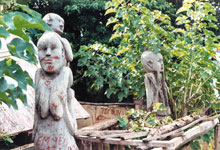Minorities find ways of life difficult

Jarai spirit sculptures surround a village grave site. Jarai is one of 54 minority groups in Vietnam.
Vietnam is home not only to the reunified ethnic Vietnamese, but also to 54 minority groups. Many of these groups reside in the Central Highlands and are called Montagnards (mountain dwellers), a name given to them by the Colonial French. Many of these groups share common traits and customs, from agriculture to the homes they live in to animist beliefs. One thing they all have in common today is that they are at a crossroads with their ways of life. They have managed for the most part to maintain their ancient ways, but Vietnam is quickly growing around them.
One village I visited is inhabited by Jarai people, who represent the largest group of Montagnards. They belong to the Austro-nesian racial group with Malayo-Polynesian language roots. They, like some of the other minorities, are a matriarchal people with extended families living in long houses built on stilts with small livestock living underneath. A stroll down to the village graveyard past the village main house (where only the men are allowed to assemble) reveals how their animist beliefs, i.e. that natural objects have conscious life, have been maintained.
In this group, multiple dead are buried in one large coffin that is reopened when someone dies. After about seven years it becomes filled to capacity and a final farewell festival is held for the spirits in that particular grave. Up to that point the villagers bring offerings to the spirits, represented by carved wooden sculptures, everything from food to cigarettes. This is quite a sight to the Western eye: miniature houses are built over the graves with fences around them to keep the livestock out. Various wooden statues are carved by the families of the deceased and placed around it. Some are guardsman-like, some are crying, and others represent new life (mother and child, couple making love, etc.). There is even a carving of a U.S. warplane that is supposed to fly the spirits into heaven.
We continued through the village past the coffee crop (short arabica and tree-like robusto), rows of corn, peppers, dry rice, guava, and other foods. They are a self-sustaining community to an extent, in that they often end up having to purchase supplemental food from Vietnamese farmers who drop by the village on occasion. Walking down a narrow path in the thick brush, we come across the place where all the washing takes place (clothes and people). The water runs right off a hill like a mini waterfall. Each gender has its own place to bathe under the open sky. Speaking of the sky, it began to rain so we quickly moved up a steep hill and back to the path, which returned us to the main part of the village.
The Vietnamese government portrays the Montagnards as a source of national pride. But while there may be truth in that, I got a better understanding while visiting this and another village of how things really are beneath the surface. As a general rule, the minorities do not like the Vietnamese. The Vietnamese have taken over minority lands, and Montagnards have been relocated. But unlike the Native Americans in the United States, the land where they have been moved to is fertile and the Vietnamese do not overtly interfere with their customs. The government does try to encourage better hygiene to reduce disease, and it has built schools in every village. Here is where the “interference” comes in: if villagers choose to send their children to school (which is compulsory but not enforced), the students have the same Vietnamese-biased curriculum as everyone else. Is this necessarily a bad thing? Hai, our local guide, said that there are a couple of Jarai people who work in his office and hold university degrees.
I quoted a passage from my handy Fodor’s Vietnam guidebook that reads, “…but today (the Montagnards) are being forced into the role of Vietnam’s underclass,” and asked my three Vietnamese friends what they thought. Surprisingly, they all agreed without hesitation. The reason makes sense: Vietnam wants to develop, but the minorities want to be left alone. The more they are left alone, the poorer they become relative to their Vietnamese neighbors. It’s an impossible situation to avoid. They directed my attention to the power lines brought out to the village by the government and to the connections dangling from the homes where the lines would go if the villagers would only decide they want electricity. They have been moved down from the hills and had sedentary farming techniques offered to them to replace their slash and burn practices. It is understandable why it would be difficult to change centuries-old customs, but it is also hard to argue against the need to cease destroying the environment.
The situation with the minorities is certainly more complex than I am able to present it here. There have also been resistance movements such as Front Unifie de Lutte des Races Opprimes, violent uprisings, refugees crossing into Cambodia and Laos causing the United Nations to get involved, and probably some other things the government does not make public.
For now, however, visitors are encouraged to learn about the ethnic minorities of Vietnam, not only in museums, but in person as well.
Your donation will support the student journalists of Missouri Southern State University. Your contribution will allow us to purchase equipment and cover our annual website hosting costs.



























